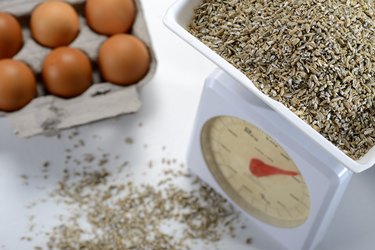
Nowadays, some popular diets — and most notably, the science-based Dietary Guidelines for Americans, 2015-2020 — dole out the amount of fat, carbohydrate and protein you should be eating as a percentage of your total calorie intake. That's not much help when you're looking at food labels, but all you need to convert the information from percentages to label-friendly grams is some simple math and an online calorie tracker.
Read More: How to Get the Facts on Food Labels
Video of the Day
Video of the Day
How Many Calories Do I Need?
Beware of fad diets that promote dramatically restricted calorie consumption for fast weight loss. While you might lose weight quickly on these diets, they're not sustainable, so the weight often comes back — and heavily calorie-restricted diets can even cause serious health problems.
Instead, turn to science-based calorie estimates like the Dietary Guidelines for Americans, 2015-2020, which estimates appropriate caloric intakes according to your age, gender and level of physical activity. These range from 1,600 calories per day at the low end (for a sedentary woman age 51 years or older) to 3,200 calories per day at the high end (an active 18-year-old man).
What Percentage of Each Macronutrient Is Best?
If you're not working with a nutritionist or doctor to reach a specific goal, the Dietary Guidelines for Americans, 2015-2020 give approximate ranges for dialing in your macronutrient ratios. As a general rule, a healthy diet is made up of 45 to 65 percent carbohydrates, 20 to 35 percent fat (with less than 10 percent coming from saturated fat) and 10 to 35 percent protein. A diet tracking app like MyPlate can help you monitor your ratios.
Some popular diets give their food ratios in percentages too. For example, the vegetarian Ornish Diet encourages taking in your calories as 10 percent fat, 20 percent protein and 70 percent carbs.
Converting From Macronutrient Percent to Grams
Once you've determined what percentage of your total calories should come from a given macronutrient, it's time to convert from those easy-to-compare percentages into easy-to-read-on-a-label grams. The formula for converting from percent to grams is:
percent × total calories ÷ calories/gram = an answer in grams
But there are a couple of catches. First, the percentage needs to be written in decimal form. That's pretty easy: Just move the decimal point two spaces to the left. So 30 percent becomes 0.30, 25 percent becomes 0.25, 65 percent becomes 0.65, and so on.
The other catch is that not every macronutrient has the same number of calories per gram. Protein and carbohydrate both have 4 calories per gram, but fat has 9 calories per gram.
If you don't consider yourself a math person, don't worry: The calculations are easy to do with the aid of a calculator, working from left to right.
Examples of the Percent-to-Grams Conversion
Example 1. Imagine that you're an active 38-year-old woman; according to the Dietary Guidelines for Americans 2015-2020, you should eat about 2,200 calories per day. You know the maximum amount of fat you should have per day is 35 percent of your diet, but how many grams is that?
Start with your formula:
percent × total calories ÷ calories/gram = an answer in grams
Now fill in the "blanks" with all the information you have. In this case percent is the percentage you want to know — 35 percent — expressed as a decimal, so that's 0.35. Your total calories per day is 2,200, and fat has 9 calories per gram. So that gives you:
0.35 × 2200 ÷ 9 = ?
Whip out your calculator; input the numbers from left to right, and you'll have:
0.35 × 2200 ÷ 9 = 85.5 grams
So the absolute highest amount of fat you should consume in a day is 85.5 grams. Note that this is not a goal number but an upper guideline — and that's quite a lot of fat.
Example 2. Work one more example to find the lower limit of the recommended fat intake, 20 percent. Because you already set up your equation for 9 calories/gram, all you have to do is change the percentage. So your new problem is:
0.20 × 2200 ÷ 9 = 48.9 grams
Given those example parameters of age and activity level, you should be eating between 48.9 and 85.5 grams of fat per day, with most of it coming from healthy sources.
- Health.gov: Dietary Guidelines for Americans, 2015-2020: Estimated Calorie Needs Per Day
- USDA: How Many Calories Are in One Gram of Fat, Carbohydrate, or Protein?
- Boston University School of Public Health: Popular Diets
- U.S. Department of Health and Human Service: Weight-Loss Nutrition Myths
- Health.gov: Dietary Guidelines for Americans, 2015-2020: Nutritional Goals for Age-Sex Groups